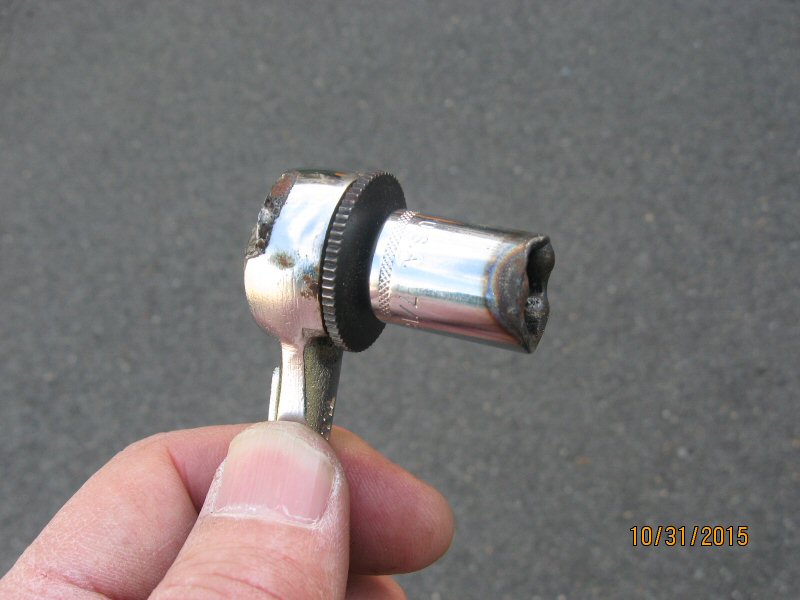
Note to Mortuary contributors: please consider that your boss may not find your submission in the best interests of your Big Company. Once in a while we get a "please remove my submission" email, try not to send us anything that you might regret.
Note to Big Companies: Don't blame us for posting your spectacular failures, we only post what your employees send us. On the other hand, please don't rip off Microwaves101 pictures for presentations without permission, that's bad manners. Maybe it's time for some training!
Note to Mortuary fans: In many cases, if you click on pictures on this page you can see higher resolution images.
New for November 2015: This image from CFH. This is what happens when you are connecting the positive terminal of a large UPS and are not careful. Ouch! This is why you are supposed to disconnect the negative terminal first and reconnect it last...

New for September 2015: More images from Jacob, plus a bonus video of a vacuum tube frying!
Have you ever thrown away a memory stick that had data on it that you wanted but thought that it was lost? Here's what Jabob had to say:
Today a colleague of the IT department asked if I could repair a broken (as in two pieces) USB stick. The USB stick was installed in the front of a PC which was on the floor. Someone hit the USB stick by accident and the pcb traces came off the pcb. Note; the same colleague always strongly advises not to place computers on the floor to prevent this types of accident. ;-)
Well, the repair... I like soldering, but SMT isn't my favorite. I like challenges and this seems a good one to test my skills. After cleaning the connector and scraping off the protective paint of the copper traces, the two pieces are placed onto a breadboard pcb using solder wire and double sided tape. Then four small wires are used to create the point to point connection. The thickness of the wire is 0,25mm/0,01" (AWG30). The soldering wire is four times thicker and the tip of the soldering iron is even six times bigger than the copper wire. That's not the ideal equipment, but surprisingly the "repair" went quite well and rather fast.
Luckily there was a stereo microscope which made the job quite easy. And the assembly works! The documents are saved and this USB stick is added to the hall of fame (or shame...)



The other day I started a repair project of a recently bought Kenwood TS-830M ham radio transceiver. The previous owner said there was "some problem" with the transmit function. After a thorough visual inspection the radio was hooked up to a variac. The voltage was (without any trouble) raised to mains level and some receiver functions were tested. I had a hunch that something was wrong. Therefore I setup a camera to record the final amplifier stage. During testing I checked the tubes visually and there was nothing wrong to be seen. Until two minutes after the powering up of the radio. The left tube started red plating, which I didn't notice.
One minute later the left tube failed by a bad flashover. I haven't examined the tube yet, but it's very likely that there's a grid/cathode short inside the tube. Grid/cathode short circuit seems to appear sometimes in these 6146B vacuum tubes. This all happened in receive mode.
The bad thing is that the previous owner soldered a wire across the (blown) mains fuse. (...) You probably can imagine the resulting damage. Probably this isn't the first time a seller lied.
New for September 2015: here's a photo of a dead hotel room key, caused by dropping a microwave circulator on top of it. Say, what do circulator suppliers do with that suitcase of product when they travel to trade shows to prevent this and other catastrophes? Our guess is they remove the magnets from the samples in the sample case.
Click here to learn if a cell phone can erase a hotel key.

New for August 2015: Here are some images from Cedric.
The pictures I attached are my most spectacular device failure to date. I was biasing a 1-port interdigital ferroelectric varactor at 80V when it decided to give up quite dramatically. Unfortunately, when the device blew, it took the $1700 Cascade Infinity probe with it. Sorry for the poor quality. I snapped them with my iPhone through the eyepiece of our probe station microscope. Hope you enjoy the pictures!


New for August 2015: here's a second installment from Jacob. I too have experience similar problems with the Ebay and Amazon "shipping departments"... what are these people thinking? We shiipped Jacob a M101 coffee mug and we are happy to report it arrived in one piece...- UE
Today I received two waveguide attenuators which I bought earlier this week. (For the record; model J382A and P382A, both from HP.) The "small" is in good shape, the "big" one... not so good. Since it was not packaged well enough, during transport one flange is badly damaged. The compression mark on the box can clearly be seen on the image, along with the other half of the flange. Luckily the cartboard box is not damaged badly and therefore it can be used again. ;-) And the attenuator... well, probably the housing will be used for another ham-radio building project...



New for July 2015, from Jacob from the Netherlands. He asked that we fix his English, we decided (we were, like...) it is as good as most American college students so corrections are not (like) needed. Like that, likers! Jacob, we are boxing up all the non-working equipment in our garage and sending it to you....
Anyone who repairs old equipment are probably familiar with bad capacitors (by aging). Mains noise from old tube amplifiers is one of the indications of bad capacitors. Sometimes bad caps can be found by visual inspection since they start to bulge. This week I found two caps in a (still working) device. That they went bad could be seen from one meter distance... The first one is leaking (a lot) of fluid and is very bad corroded. The other one is dried out. When it was shaken, there is clearly a rattling sound to be heard. The exact age of the caps isn't known.
. They are at least two decades permanent in use; at least 175.000 hours...
On the image in the middle are two voltage regulators shown. The right one is as it should look like. The left one is exploded. It's very likely this happened by overvoltage and not by a production fault.
On the image is a Siemens Logo! plc shown. This (brand new) one was wired to 230VAC. Since this is a 24VDC model, the result was a lot of smoke and a 16A blown fuse. Since my colleagues know ham-radio operators can use all kinds of broken equipment for components it was brought to me. Fixing was worth trying so the relics of the evaporated component were removed and the evaporated pcb trace was replaced by a piece of wire. After cleaning up the black stains, the plc was wired to a 24VDC power supply. And it's alive again! Resurrection after electrocution is not bad I guess..



New for June 2015! Most Big Companies have a Company Store where you can get your kids outfits with the company name on them for the summer picnic in order to kiss up to management. Click here to listen to Tennessee Ernie Ford sing about the company store written when this institution had a darker connotation... All manner of items can be purchased at the company store, even golf balls. It came to our attention that Northrop Grumman ordered a large quantity of golf balls with their name inscribed. Too bad whoever placed the order with the Chinese supplier didn't know how to spell "Grumman". We've all seen "Northrop" spelled "Northrup", but come on... Thanks to The Other American Pharoah!

New for May 2015: This image came from Bill in Tampa. An unlucky squirrel crawled into a power meter and learned Ohm's Law the hard way. Ouch!

New for March 2015: this image is a photo of a booth at GomacTech 2015. Check out the way the dime has been sliced by the camera. Or was it circumcized?
